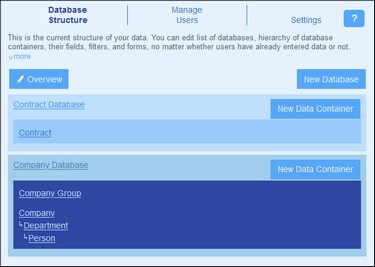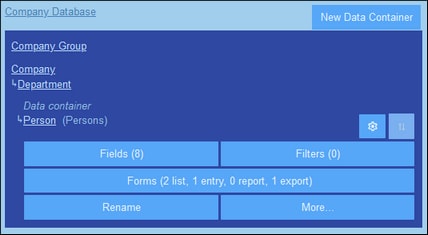Create/Edit Containers
Add a container
Add a container as follows:
•Top-level containers are added by clicking New Data Container (see screenshot below) and then defining the container's fields and other properties.
•For any container, a parent or child container can be added: (i) Click the container, (ii) Select More, (iii) Click Add parent data container to add a parent container or Add child data container to add a child container. The addition of a parent or child leads to the creation of either top-level containers or descendant containers of a top-level container. See More Operations for details.
| Note: | A top-level container can also be added by adding a parent container to an existing top-level container. Also see the Parent/Child operation, which enables you to move a container to a new hierarchy. |
Define/edit a container's fields
When you add a container (top-level, parent, or child) you are prompted for the container's name and the plural form of the name. (The plural is needed for use in text strings of the interface and reports. It provides a method to handle irregular plural forms (such as children instead of childs). On clicking Continue, the Edit Fields form appears. This form enables you to create new fields for the container, and is described in the section Fields.
The same Edit Fields form appears when you click a container and then its Fields button (see screenshot below). You can then click an existing field to edit it. See the section Fields for a description of how fields are edited.
After you create and save a new field, it is added to the existing fields of the container. For example, you can see that the Person container in the screenshot above has eight fields. (You can click Fields to add a new field or to edit an existing field.) Once a field has been defined for a new container and saved, the container is displayed in the Database Structure tab of the Configuration Page.

